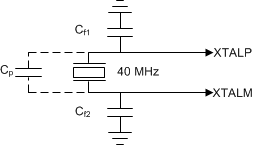ZHCSH27B May 2017 – April 2018 IWR1642
PRODUCTION DATA.
- 1 器件概述
- 2 修订历史记录
- 3 Device Comparison
- 4 Terminal Configuration and Functions
-
5 Specifications
- 5.1 Absolute Maximum Ratings
- 5.2 ESD Ratings
- 5.3 Power-On Hours (POH)
- 5.4 Recommended Operating Conditions
- 5.5 Power Supply Specifications
- 5.6 Power Consumption Summary
- 5.7 RF Specification
- 5.8 CPU Specifications
- 5.9 Thermal Resistance Characteristics for FCBGA Package [ABL0161]
- 5.10
Timing and Switching Characteristics
- 5.10.1 Power Supply Sequencing and Reset Timing
- 5.10.2 Input Clocks and Oscillators
- 5.10.3
Multibuffered / Standard Serial Peripheral Interface (MibSPI)
- 5.10.3.1 Peripheral Description
- 5.10.3.2
MibSPI Transmit and Receive RAM Organization
- Table 5-7 SPI Timing Conditions
- Table 5-8 SPI Master Mode Switching Parameters (CLOCK PHASE = 0, SPICLK = output, SPISIMO = output, and SPISOMI = input)
- Table 5-9 SPI Master Mode Input Timing Requirements (CLOCK PHASE = 0, SPICLK = output, SPISIMO = output, and SPISOMI = input)
- Table 5-10 SPI Master Mode Switching Parameters (CLOCK PHASE = 1, SPICLK = output, SPISIMO = output, and SPISOMI = input)
- Table 5-11 SPI Master Mode Input Requirements (CLOCK PHASE = 1, SPICLK = output, SPISIMO = output, and SPISOMI = input)
- 5.10.3.3 SPI Slave Mode I/O Timings
- 5.10.3.4 Typical Interface Protocol Diagram (Slave Mode)
- 5.10.4 LVDS Interface Configuration
- 5.10.5 General-Purpose Input/Output
- 5.10.6 Controller Area Network Interface (DCAN)
- 5.10.7 Serial Communication Interface (SCI)
- 5.10.8 Inter-Integrated Circuit Interface (I2C)
- 5.10.9 Quad Serial Peripheral Interface (QSPI)
- 5.10.10 ETM Trace Interface
- 5.10.11 Data Modification Module (DMM)
- 5.10.12 JTAG Interface
- 6 Detailed Description
- 7 Monitoring and Diagnostics
- 8 Applications, Implementation, and Layout
- 9 Device and Documentation Support
- 10Mechanical, Packaging, and Orderable Information
5.10.2.1 Clock Specifications
The IWR1642 requires external clock source (that is, a 40-MHz crystal or external oscillator to CLKP) for initial boot and as a reference for an internal APLL hosted in the device. An external crystal is connected to the device pins. Figure 5-3 shows the crystal implementation.
NOTE
The load capacitors, Cf1 and Cf2 in Figure 5-3, should be chosen such that Equation 1 is satisfied. CL in the equation is the load specified by the crystal manufacturer. All discrete components used to implement the oscillator circuit should be placed as close as possible to the associated oscillator CLKP and CLKM pins.

Table 5-5 lists the electrical characteristics of the clock crystal.
Table 5-5 Crystal Electrical Characteristics (Oscillator Mode)
| NAME | DESCRIPTION | MIN | TYP | MAX | UNIT |
|---|---|---|---|---|---|
| fP | Parallel resonance crystal frequency | 40 | MHz | ||
| CL | Crystal load capacitance | 5 | 8 | 12 | pF |
| ESR | Crystal ESR | 50 | Ω | ||
| Temperature range | Expected temperature range of operation | –40 | 105 | ºC | |
| Frequency tolerance | Crystal frequency tolerance(1)(2)(3) | –50 | 50 | ppm | |
| Drive level | 50 | 200 | µW |
In the case where an external clock is used as the clock resource, the signal is fed to the CLKP pin only; CLKM is grounded. The phase noise requirement is very important when a 40-MHz clock is fed externally. Table 5-6 lists the electrical characteristics of the external clock signal.
